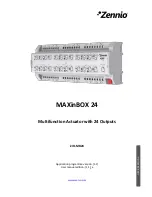If CPHA=1, the TX underflow flag, TXUF, will be set on the first setup clock edge of a frame in slave mode if TX data is not available. If
CPHA=0, TXUF is set if data is not available in the transmit buffer three HFPERCLK cycles prior to the first sample clock edge. The
RXDATAV flag is updated on the last sample clock edge of a transfer, while the RX overflow interrupt flag, RXOF, is set on the first
sample clock edge if the receive buffer overflows. When a transfer has been performed, interrupt flags TXBL and TXC are updated on
the first setup clock edge of the succeeding frame, or when CS is deasserted.
16.3.3.3 Master Mode
When in master mode, the USART is in full control of the data flow on the synchronous bus. When operating in full duplex mode, the
slave cannot transmit data to the master without the master transmitting to the slave. The master outputs the bus clock on USn_CLK.
Communication starts whenever there is data in the transmit buffer and the transmitter is enabled. The USART clock then starts, and
the master shifts bits out from the transmit shift register using the internal clock.
When there are no more frames in the transmit buffer and the transmit shift register is empty, the clock stops, and communication ends.
When the receiver is enabled, it samples data using the internal clock when the transmitter transmits data. Operation of the RX and TX
buffers is as in asynchronous mode.
16.3.3.4 Operation of USn_CS Pin
When operating in master mode, the USn_CS pin can have one of two functions, or it can be disabled.
If USn_CS is configured as an output, it can be used to automatically generate a chip select for a slave by setting AUTOCS in
USARTn_CTRL. If AUTOCS is set, USn_CS is activated before a transmission begins, and deactivated after the last bit has been trans-
mitted and there is no more data in the transmit buffer.
The time between when CS is asserted and the first bit is transmitted can be controlled using the USART Timer and with CSSETUP in
USARTn_TIMING. Any of the three comparators can be used to set this delay. If new data is ready for transmission before CS is deas-
serted, the data is sent without deasserting CS in between. CSHOLD in USARTn_TIMING keeps CS asserted after the end of frame for
the number of baud-times specified.
By default, USn_CS is active low, but its polarity can be inverted by setting CSINV in USARTn_CTRL.
When USn_CS is configured as an input, it can be used by another master that wants control of the bus to make the USART release it.
When USn_CS is driven low, or high if CSINV is set, the interrupt flag SSM in USARTn_IF is set, and if CSMA in USARTn_CTRL is set,
the USART goes to slave mode.
16.3.3.5 AUTOTX
A synchronous master is required to transmit data to a slave in order to receive data from the slave. In some cases, only a few words
are transmitted and a lot of data is then received from the slave. In that case, one solution is to keep feeding the TX with data to trans-
mit, but that consumes system bandwidth. Instead AUTOTX can be used.
When AUTOTX in USARTn_CTRL is set, the USART transmits data as long as there is available space in the RX shift register for the
chosen frame size. This happens even though there is no data in the TX buffer. The TX underflow interrupt flag TXUF in USARTn_IF is
set on the first word that is transmitted which does not contain valid data.
During AUTOTX the USART will always send the previous sent bit, thus reducing the number of transitions on the TX output. So if the
last bit sent was a 0, 0's will be sent during AUTOTX and if the last bit sent was a 1, 1's will be sent during AUTOTX.
EFM32JG1 Reference Manual
USART - Universal Synchronous Asynchronous Receiver/Transmitter
silabs.com
| Smart. Connected. Energy-friendly.
Preliminary Rev. 0.6 | 469


















